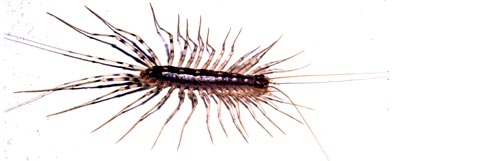House Centipede

House Centipede
This house centipede looks like a moving hair brush. It runs rapidly, holding its body well elevated, suddenly stops, then runs again toward concealment. It is one to two inches long, with very long slender antennae and 15 pairs of long legs. The grayish yellow to brown body has 3 longitudinal dorsal stripes, and the legs are banded with white. This centipede has compound eyes. They can readily detach their legs if grasped by an enemy. The last pair of legs is very long and is modified to hold its victims.
This species of centipede is found in wet damp places, especially in basements, in potted plants that are over watered and in bathrooms. Their bite can be painful, but is not generally toxic to humans.
Biology:
Centipedes (~2,800 species) are found in both warm and temperate countries worldwide. They are highly predaceous arthropods, nocturnal in activity and disturbing when found indoors. Although generally flattened in shape, species occur in many different forms, and can vary from an inch long, up to a foot in length for some tropical species. Their normal diet consists mostly of smaller insects. However the largest centipedes can feed on mice, birds and even toads. Their preferred habitat is under ground, under stones and in decomposing wood. Because centipedes, unlike most insects, have no outer wax layer to protect themselves from desiccation, they must stay in a moist habitat.
All centipedes can be recognized by the fact that each body segment bears a single pair of limbs used for locomotion. The head itself has a pair of multi-segmented antennae and three pairs of mouth parts. The first pair is toothed mandibles, the second pair is maxillae, and the third pair form leg-like palps. Behind the head is the first segment of the body, and it is this segment which has a pair of poison-claws used for prey capture and killing. It is also this poison claw which is used to inject venom when centipedes bite man. Centipede venom is not generally toxic although it may cause extreme pain to humans. Fortunately, bites are rare unless centipedes are accidentally handled.
Species of centipedes can have anywhere from fifteen to well over a hundred pairs of legs, but however many, the number is always odd. Their flattened body allows them to squeeze through narrow cracks and crevices in search for prey and their large number of legs helps them to rundown prey once discovered. Their extreme agility may cause alarm when they “scoot” across the floor. There are few enemies of centipedes although one particular species, if attacked, will spontaneously detach legs that continue to wiggle, distracting any predators.
Centipedes may deposit from 50 to 100 eggs and some females may actually spend time defending their eggs. However, if hungry, females have been known to devour their young. It may take longer than three years for some eggs to mature into adult centipedes and once mature, adults may live for more than five years. This longevity makes them good display models in live insect zoos.
Control:
Getting rid of centipedes can be very difficult. They breed under foundations and in moist leaf litter where it is not easy to reach them. Adults can move up into buildings via small cracks in the foundation as they search for prey. Once exposed inside a building they must quickly return to a humid habitat to avoid desiccation. Since their search image is probably moving prey, they are not likely to feed on baits.
This means that setting out sticky traps is probably the best first line of defense. These traps will not only attract and capture centipedes but will strongly indicate population levels and potential routes of access. Experience shows that traps placed at floor level in moist areas do best. Traps do have to be kept fresh because it takes a good sticky trap to hold the larger species of centipede.
The use of pesticides as either an outside perimeter spray or as an interior perimeter spray will only have minimal effect. The centipedes will still travel for a time and the sight of a dead centipede on the floor or trapped in a bathtub is not much better than seeing a fast one flee to safety at night. Dead centipedes that accumulate inside a building will serve as a food source for carpet beetles and other urban pests. Therefore it is really best to capture specimens, reduce moisture and seal out routes of entry.
Reducing moisture under the foundation will help to control centipedes. Make sure that water accumulated from roof top areas is drained well away from the building foundation. For the same reason keep leaves, wood, compost and other organic material away from the side of the building.
Occasionally centipedes are carried directly into a facility along with the delivery of potted plants and other material. As the soil dries out, the centipedes are forced out into the building looking for prey and a humid habitat. In this case it is important to screen and identify temporary sources of infestation so that control can be focused on the source.
Click On The Pest Category To Learn More.
| Bedbug Guide | House Centipedes |
| Carpenter Ants | Mosquitoes |
| Clothes Moths | Roaches |
| Fly Facts | Ants vs Termites |
| Little Black Ant | Termites |
| Odorous House Ant | House Flies |
| Fruit Flies | Rodents |






